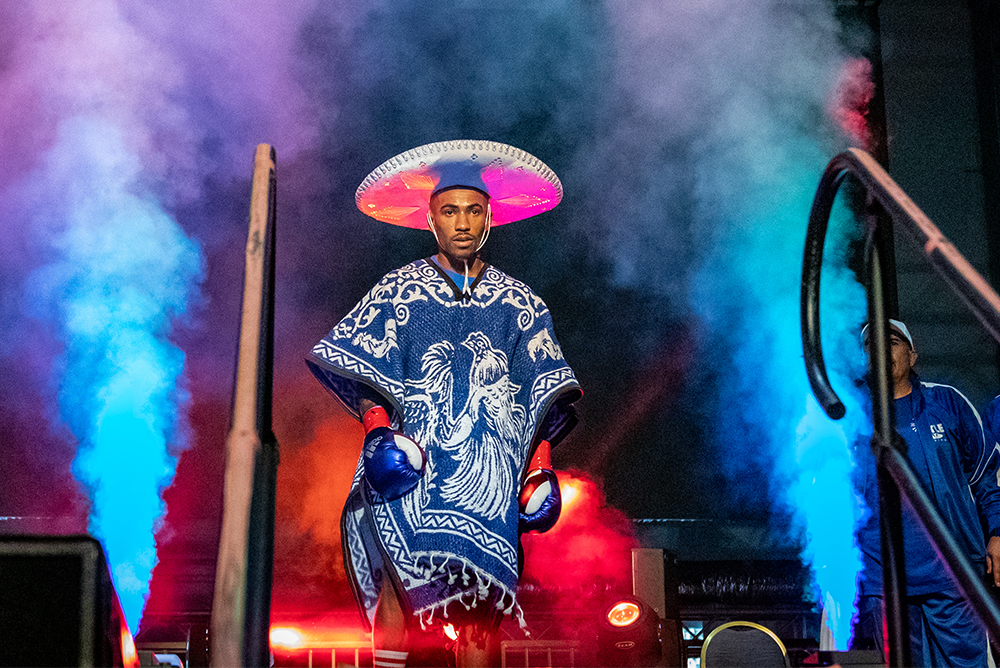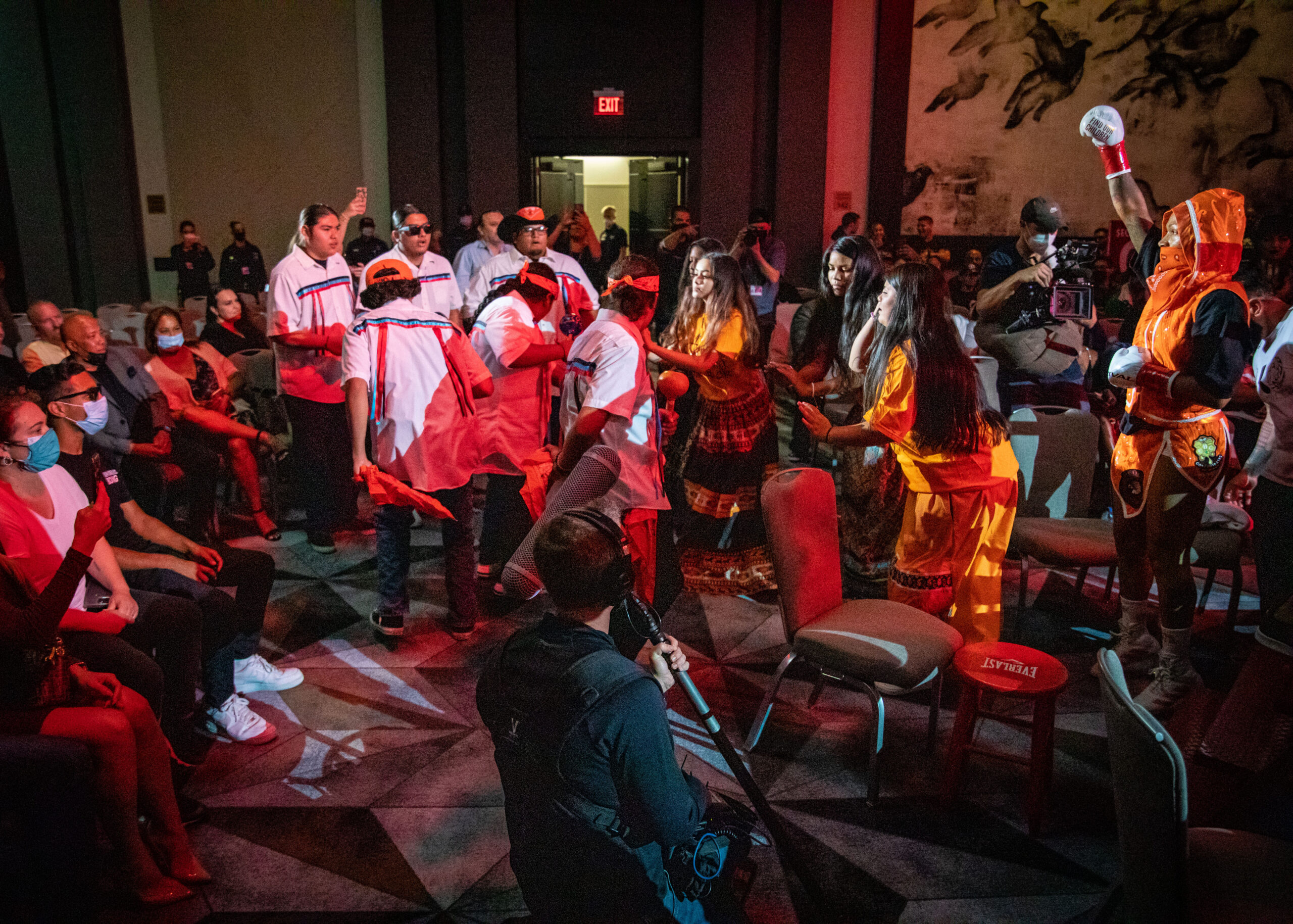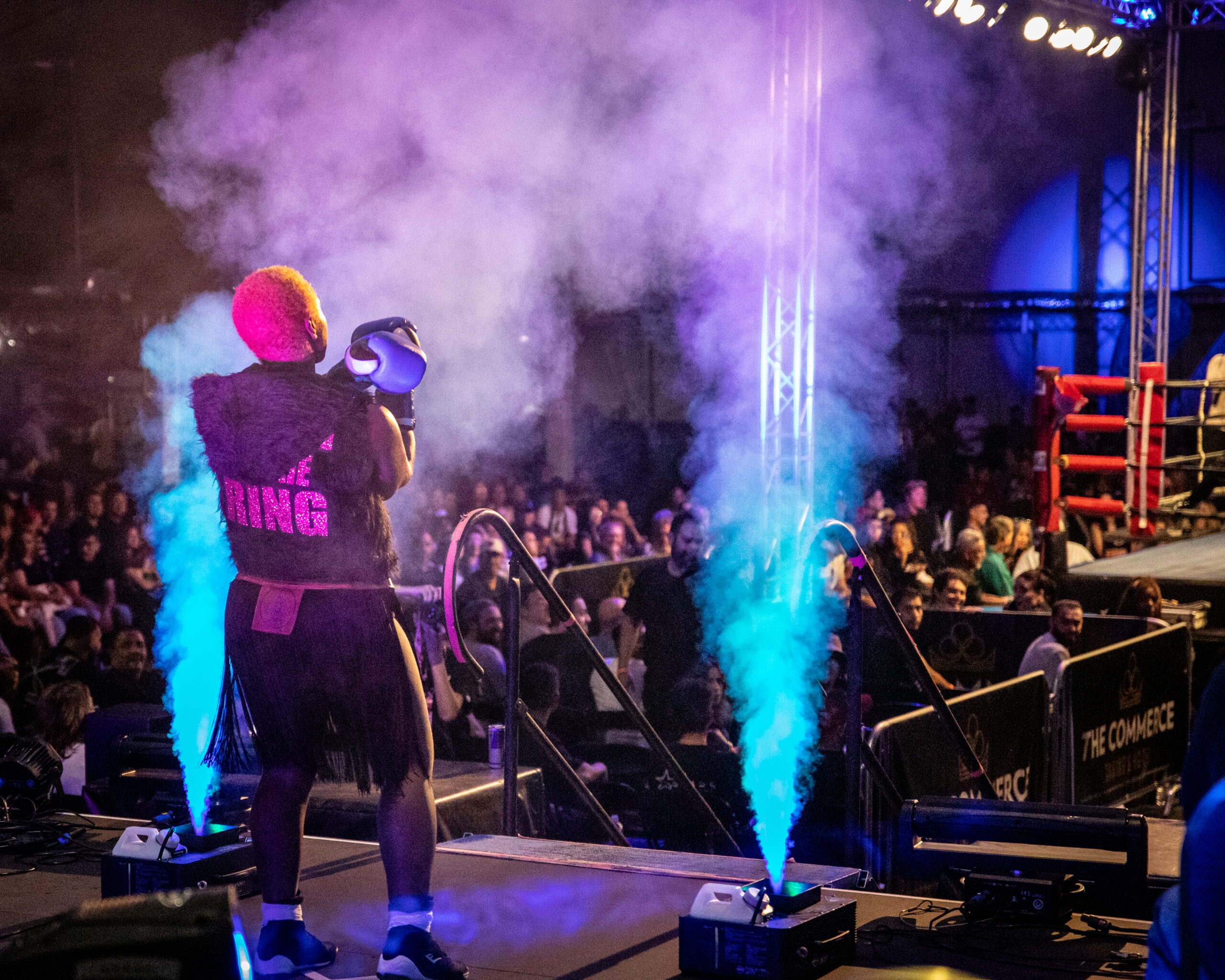
A boxer’s entrance is more than just flash. It’s how they make their mark in the sport and the world, scholar Rudy Mondragón writes. Above, William “El Gallo Negro” King wears a Mexican sarape with a rooster and a sombrero de charro, embracing his Afro-Mexican roots. Photo by Rudy Mondragón.
The first time I really paid attention to boxing ring entrances—the long, celebratory walks fighters take from their dressing rooms to the ring before a bout—was in 1992, when I watched the classic match between Julio César Chávez and Hector Camacho that symbolically pitted Mexico against Puerto Rico. I was a 7-year-old U.S.-born Mexican, yet it was Camacho’s entrance that drew me in: the blaring strains of McFadden and Whitehead’s “Ain’t No Stoppin’ Us Now”; the flashy Captain Puerto Rico outfit; the way Camacho danced his way to the ring.
Camacho lost the fight, but he won the narrative—at least, as far as I was concerned. His ring entrance was a bravado performance of political and cultural resistance. It made such a strong impression on me that it launched me into my career researching the political economy of boxing. Today, I excavate ring entrances to understand the ways boxers make their mark on their sport—and the world.
The ring entrance allows boxers to reach new markets and increase their earning potential. It also provides a way for them to express themselves, and to communicate messages of political and cultural dissent. For this reason, the boxing ring entrance is the most important ritual in sport. It forces the world to witness boxers in all their performative glory.
Every single boxer in the history of the sport, dating back to the establishment of the 1867 Marquess of Queensberry rules, has made that long walk. Jack Johnson blew kisses at racist fans who razzed him in Sydney in 1908, and enjoyed adulation during ring entrances in later decades. In 1989, Sugar Ray Leonard entered the ring to fight Thomas “Hitman” Hearn wearing a white and red-striped robe with the word “Amandla” stitched on the back. Amandla is the isiNguni word for power, and was used by the African National Congress as a rallying cry in efforts against apartheid in South Africa. Ring entrances are spaces where boxers exercise agency and express their cultures, lived experiences, and social identities.
An effective political ring entrance has three crucial components. The first is music, which helps boxers communicate pointed messages. In the 1990s, when Mike Tyson entered the ring to Public Enemy’s “Welcome to the Terrordome,” it amplified Black hip-hop culture, and Chuck D’s powerful message. When I spoke with Chuck D and asked him what it meant to him when Tyson entered the ring to Public Enemy’s song, he replied, “Well, Tyson never lost when he did.” By linking his athletic prowess to a soundtrack that spoke truth to power, Tyson legitimated and boosted calls against racial violence.
The second is fashion and style. Boxers get to select their own uniforms and ring outfits, and their fashion choices are often connected to their lived experience and culture. World champion Kali Reis describes her purple-and-white, wampum-festooned trunks as “boxing regalia”—and they are a direct manifestation of her experiences as a multiracial Black Indigenous woman, hearkening to the tradition of fancy dancing, a type of dance performed at powwows that was reserved for men until Indigenous women challenged that societal norm. Kali is part of this rich rebellious history. By wearing garments that express her identity, she rebels against dominant structures and ideologies.
The final crucial component is an entourage. Popularized by Sugar Ray Robinson, the entourage is a traveling team, rooted in a boxer’s obligation to bring along the people who have contributed toward their success. Entourages are also a way to show the world who you are and what you stand for. In 2002, world champion boxer Fernando Vargas was scheduled to fight against Oscar De La Hoya. Vargas entered the ring with his boxing hero Julio César Chávez, a Mexican boxing icon who represented a Mexican working-class ethos, to express his pride in being Brown and Mexican. This ring entrance was particularly powerful given its timing: In post 9/11 America, the population of immigration detention centers was rising, along with anti-immigrant sentiment.
Today, fighters such as José Ramirez continue to use ring entrances for collective empowerment. Ramirez’s parents were Mexican immigrants to California’s Central Valley, and he grew up witnessing the harsh work conditions they endured doing agricultural work. Ramirez started boxing at seven; at 14, he began working the bell pepper fields to help his family. Somehow, he kept up his training. In 2012, he represented the U.S. at the London Olympics, and soon after, he made his professional debut.
In the first years of Ramirez’s career, he partnered with the California Latino Water Coalition to raise awareness about funding for water infrastructure. When Donald Trump became president, and delivered his now-infamous speech calling Mexican immigrants murderers and rapists, Ramirez leaped to action again. At his first world title fight, against Amir Imam in March 2018, he used his ring entrance to unveil a pro-immigrant, anti-Trump message. He wore a white and red Fresno baseball jersey and a red cap, similar to Trump’s MAGA hats, but refashioned with the message “Pro-Immigrant and Proud.” His trainer at the time, the famed Freddie Roach, accompanied him to the ring, wearing the same hat. Ramirez won the fight, earning the World Boxing Council World Super Lightweight championship.
I made it my priority to attend his next fight, in Fresno, and to sit ringside, so I could see what he would do next.
Seconds before Ramirez’s descent to the ring, fans yelled, “You can do this s–t!” and “Avenal homie!,” referencing his Central Valley hometown. Ramirez and his entourage stood at the edge of the tunnel, wearing their “Pro-Immigrant and Proud” hats and t-shirts and waiting for their cue. The sounds of his theme song, “Yo Soy José De Avenal” started playing, and they began their walk.
The song was performed live by Chuy Jr. (son of Jesus “Chuy” Chavez of the well-known norteño group Los Originales de San Juan), who composed the song for Ramirez in 2017. A corrido, or traditional Mexican narrative song, it is about Ramirez’s roots in Avenal, his perfectionism in and out of the ring, his courageous no-quit spirit, his family, and his mother’s hometown of La Piedad, Michoacán. Its lyrics frame a compelling counternarrative to Trump’s racist rhetoric. For the 80 seconds of Ramirez’s ring entrance, the fight centered Mexican culture, unity, and the visibility of undocumented immigrants.
I sat down with Ramirez a few weeks after this fight and asked him what “pro-immigrant and proud” meant to him. Whether it was our president or our neighbors, he explained, “the reason they like to divide people is to make them weak. The message is for me to remind everyone that they should be proud that they’re immigrants and they come here and are doing something positive.”
Ring entrances are ephemeral, only lasting a few minutes. But through music, fashion and style, and entourages, these shows subtly and overtly communicate pride, dignity, and at times political protest. Beyond the pyrotechnics and pageantry, there is a story in every ring entrance.







Send A Letter To the Editors